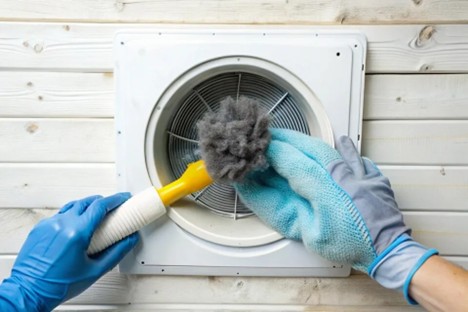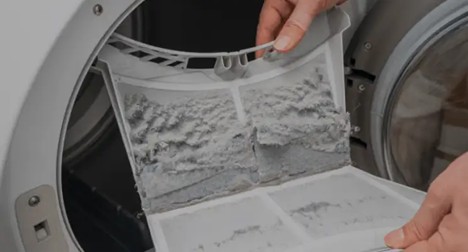
When we think about summer safety, our minds often go to sunscreen, pool rules, and avoiding heatstroke. But there’s a lesser-known hazard that hides in plain sight, right in your laundry room.
Hot weather combined with clogged dryer vents creates a serious fire risk.
During the summer, households typically see a spike in laundry chores, thanks to wet towels, sandy swimsuits, sweaty clothing, and piles of kids' gear. With your dryer working overtime, lint buildup becomes more dangerous. That’s why scheduling professional dryer vent cleaning is essential. It helps ensure your system runs safely and efficiently during the season when it’s working hardest.
In fact, according to the U.S. Fire Administration, nearly 3,000 home fires every year are caused by clothes dryers and the leading cause is lint buildup in the dryer vent system. Add soaring summer temperatures to the mix, and you’ve got a perfect storm for disaster.
Your dryer works by forcing hot air through wet clothes to evaporate moisture. That hot, moist air is then pushed through a vent system and out of your home. But as your clothes tumble, they shed tiny fibers (lint) that get trapped in the lint trap and also accumulate in the exhaust vent over time.
When your dryer vent is clogged with lint, airflow becomes restricted. This causes several problems:
Now add hot outdoor temperatures to the equation. During summer, your dryer already has to work harder to overcome the heat and humidity in the air. When it’s 90+ degrees outside, internal temperatures inside your dryer and vents can spike dramatically, creating the perfect environment for lint to ignite.
This is why summer is peak season for dryer fires, even though most people don’t associate warm weather with this particular risk.
Summertime laundry comes with unique challenges:
These heavy, frequent loads generate more lint and more heat which puts extra strain on an already clogged system. Even if you clean your lint trap regularly, that only captures a portion of the debris. The rest travels through the vent duct and builds up in hard-to-reach areas.
Not sure if your vent needs cleaning? Look for these common warning signs:
Clothes take longer than usual to dry
If a typical load is still damp after one cycle, airflow is likely restricted.
The outside of the dryer feels hot
Overheating can be a sign that hot air isn't venting properly.
A burning smell or hot, humid laundry room
These are major red flags. Shut off your dryer immediately and investigate.
Lint or debris around the dryer vent exit
Check the outside vent hood, visible lint here usually means there’s much more inside.
Excess lint behind or under the dryer
Lint should be going out the vent, not collecting around your machine.
The dryer stops mid-cycle or triggers a safety shut-off
Newer dryers sometimes shut off automatically when overheating is detected.
If you notice any of these signs, don’t ignore them. The risk only increases as temperatures rise.

Even if a fire doesn’t occur, a clogged dryer vent can still cause problems:
Higher energy bills: Longer drying times = more electricity use.
Wear and tear on your dryer: Overheating shortens your appliance’s lifespan.
Mold and mildew: Moisture buildup in a blocked vent can lead to mold growth inside your home.
Air quality issues: Clogged vents can cause carbon monoxide backflow in gas dryers, a potentially deadly hazard.
Regular vent cleaning not only protects your home from fire but also improves appliance efficiency and indoor air quality.
The general recommendation is to have your dryer vent professionally cleaned at least once a year. But in high-use households, especially those with large families, pets, or lots of summer laundry, you may need it more frequently.
If you’re unsure when your vent was last cleaned, now is a good time to schedule it. Summer is when your dryer is working hardest, and waiting too long could mean rolling the dice on safety.
You might be tempted to clean the vent yourself, and for shorter, straight ducts, a DIY cleaning brush can help with surface lint. However, most homes have vent systems that:
That’s why professional vent cleaning is often the best and safest option. Professionals use high-powered vacuums, rotary brushes, and air tools to thoroughly remove lint buildup, even deep within the system. They also inspect for any duct damage, blockages, or disconnected vents that could cause problems down the road.
On top of this, experienced technicians will most likely:
Homeowners should schedule a cleaning to make sure their system is operating safely and efficiently.
Dryers are one of the most used and most overlooked appliances in our homes. We rely on them heavily, especially during summer months, without often thinking about the hidden dangers lurking just beyond the lint trap.
Clogged dryer vents combined with high summer temperatures are a recipe for disaster, but it’s one you can easily prevent with a little attention and care. So, before you throw in that next load of towels or swimwear, ask yourself: When was the last time your dryer vent was cleaned?
If it’s been more than a year, or you’ve never had it done, now’s the time to take action.